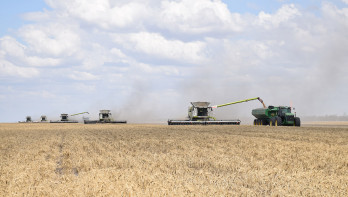Analysis Grains
Drought is a problem for soybeans in Argentina
The weather is becoming more central in the grain market. Rain is forecasted for the dry Black Sea region. However, this does not have the positive effects on winter grains that one would hope for. In South America, concerns about the condition of soybeans are also increasing due to a lack of moisture.
The March wheat contract on the Matif closed $1.50 higher at $232.75 per ton yesterday. Wheat also closed in the green on the CBoT, up 0.3% to $5.48¼ per bushel. Corn took a step back, closing 0.4% lower at $4.52¼ per bushel. Soybeans closed the last trading session 0.2% higher at $9.82 per bushel.
Rain is forecasted for the eastern Ukraine and southern Russia in the coming days. At first glance, this seems like good news for these areas that have been plagued by drought throughout the fall and winter. The Russian meteorological institute warns that precipitation could significantly worsen the condition of winter grains. Due to the combination of moisture and above-average temperatures, the grains continue to grow during the winter. However, new shoots are sensitive to frost, as warned by the Russian state weather bureau. If the weather changes later this winter, the moist conditions could still cause significant problems.
The price of Russian wheat is on the rise. Ikar raised the quotation by $3 to $237 per ton this week. Egypt was the main buyer of wheat from Russia in the first half of the export season (from July to December). This is according to the Russian news agency Interfax based on data from Rusagrotrans. Egypt imported 5.3 million tons of wheat in the last six months, which is 1.8 times the import during the same period a year earlier. Egypt recently announced that it has secured enough wheat to last until the end of June. Bangladesh is the second largest customer of Russia with 2.14 million tons. Turkey ranks third with 2.08 million tons, importing 33% less wheat compared to the same period last year.
Drought in Argentina
Soybeans received some support due to ongoing drought in Argentina. Little to no rain is forecasted for a large part of the country in the next two weeks. The grain exchange in Buenos Aires has reduced the expected soybean area in Argentina by 1.1% to 18.4 million hectares. Margins are under pressure in soybean cultivation, leading farmers to choose other crops. However, 85% of the planned soybean area has already been sown, according to the Buenos Aires grain exchange.
Setbacks in Argentina may not immediately pose a major problem for soybean availability. Several analysts point out that soybeans are doing well in Brazil. The USDA's agricultural attaché estimates the upcoming harvest in Brazil at 165 million tons. Brazil harvested 153 million tons of soybeans last year according to the USDA's latest Wasde report.




